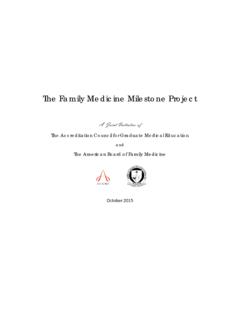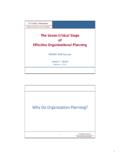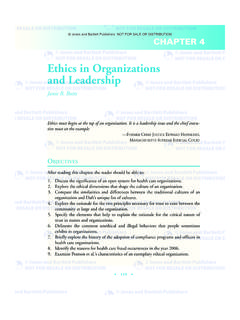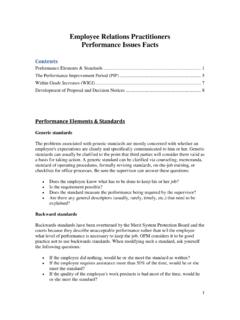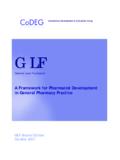Transcription of CHAPTER 1 The Informal Sector: What Is It, Why Do …
1 21 CHAPTER 1 The Informal sector : what Is It,Why Do We care , and HowDo We Measure It?SUMMARY:This CHAPTER seeks to unpack our understanding of the terminformality,why we may care about it, andwhat dynamics may be driving its elements. The number of phenomena it encompasses and the limitations of its measuresare manifold, dictating caution in employing the term. Yet two stylized facts remain: First, however measured, Informal -ity is high in Latin America, although not obviously so for the region s level of development; and it remains an importantphenomenon.
2 Second, in several countries it has experienced striking increases over the last decades. Whatever adverse reg-ulatory, poverty, growth, or social morale implications informality may have, they have become more relevant with urban traditionalsector, and so on. These termsbeggar analysis by assuming what has to be demon-strated (Hart 1973, p. 68).With this, Hart cautions us against inquiry with exces-sively well-informed ideas of what we may , the accumulation of rich data sets over thelast decades has cast progressively more light on the realmof the Informal , permitting us to document the greatheterogeneity of actors and their raz n de ser.
3 Among themwe find the following:Labor: workers, particularly the old and young, who wouldprefer a job with standard labor protections, but areunable to get one; workers who have quit formal sector jobs to start amicrobusiness to be their own boss, make more money,and avoid paying social protection taxes; and womenleaving formal salaried jobs for the flexibility of bal-ancing home and income-raising : microentrepreneurs with no intention of or potentialfor growing, and hence no intention of engaging theinstitutions of civil society;Introduction: what is informality?
4 The term informalitymeans different things to differentpeople, but almost always bad things: unprotected workers,excessive regulation, low productivity, unfair competition,evasion of the rule of law, underpayment or nonpayment oftaxes, and work underground or in the of adjectives from very distinct fields of studysuggests that we may have a classic blind men and the ele-phant problem everybody touches part of the animal,but understands only the part that they touch. More likelystill, we are exploring several distinct phenomena as weattempt to describe one ungainly composite informality.
5 To further complicate things, Keith Hart, the purportedcoiner of the term informality(and one who did not thinkthe sector was necessarily bad), argued that the source ofour blindness the undocumented nature of the sector left the sector especially vulnerable to being a tabula rasaonwhich analysts projected their particular concerns:Most enterprises run with some measure of bureaucracyare amenable to enumeration by surveys, and, as such,constitute the modern sector of the economy. Theremainder that is, those who escape enumeration arevariously classified as the low-productivityurban sector , the reserve army of the underemployed and unemployed, 5/8/07 7:10 PM Page 21 microentrepreneurs stymied in their expansion byexcessively high barriers to registering with the gov-ernment and thereby accessing other inputs offeredby the Informal .
6 Firms and individuals avoiding taxation or othermandated regulations because everybody else does,and because enforcement is weak and uneven; firms registering only part of their workers and part oftheir sales or declaring only part of the salary oftheir workers due to an excessive regulatory far from exhaustive, these three pairs are illus-trative of the variety of types of agents captured under therubric of informality and, further, capture three differentmargins of informality discussed later.
7 They also suggestthe reasons we care about do we care about informality?Each example above has a different underlying logic andreason for being and, hence, a reason that we may careabout its existence or size from a policy familiesAs the regional flagship report Securing Our Future(deFerranti et al. 2000) noted, while development is often seenas a process of increasing income, in practice we have alsoseen the emergence of institutions to shelter families fromadverse shocks, be they loss of job, illness, or naturalcalamity.
8 The presence of a large fraction of the workforcein Latin America that does not count on formal mecha-nisms to hedge or mitigate these shocks is, hence, of intrin-sic concern. what complicates policy making is that, as thechapters in this volume will show, workers often choosejobs that lack such benefits or they willingly leave jobs thatoffered such benefits, valuing more other characteristics ofinformal jobs. In this case, the worker and his/her familymust be at least as well-off as before, but may still be vul-nerable to some types of misfortune (in particular, health)for which Informal protections are few.
9 There also may beexternalities for society in, for instance, the classic case offamilies undersaving for retirement. Further, if, as is sug-gested throughout this report, some informality is due tothe low valuation of government-provided services com-pared with their implicit or explicit costs to workers, thena choice to be unprotected may point to a dysfunctional andinefficient social protection on productivity and growthRigidities in either the labor or product market that preventthe optimal allocation of workers among sectors generallylead to output and welfare losses.
10 Regulatory failures thatlead to higher informality may have a direct impact on pro-ductivity. But beyond this, informality itself has been pos-tulated to have adverse impacts on productivity. As noted inPoverty Reduction and Growth: Virtuous and Vicious Circles(Perry et al. 2006), workers uninsured against health, oldage, and other risks may have lower productivity and fewerincentives to invest in human capital accumulation. Firmsunable to access credit, larger sales/product markets, andsources of innovation, and those evading taxes may operateat a suboptimal scale.











